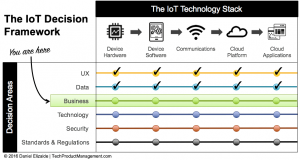Guest Post by Daniel Elizalde, TechProductManagement
With their ability to gather data after a product has been deployed, IoT products provide a platform to generate new and innovative business models that haven’t been seen before. In this post, I describe some of the most interesting ways to monetize your IoT product today.

I recently attended a very popular IoT conference in Silicon Valley. During a presentation, the keynote speaker asked the audience, “Who here is building a connected product?” About two-thirds of the audience raised their hand. Then he asked, “Who is making money with IoT today?” No hands went up this time.
This little engagement trick reinforced the fact that many companies are jumping into the opportunity of building IoT products without a clear monetization strategy, or put more simply, a strategy for how to make money from your IoT product.
Based on the IoT Decision Framework, you are here:
Subscription Model
One of the greatest benefits of a connected device is that it enables recurring revenue. Now instead of having a one-time sale, you can offer a subscription model in which you charge your customer a fee for providing continuous value.
A subscription model enables you to implement many of the benefits available to software-only products within your IoT solution. Basically, you are introducing an “as a Service” model but for a system including both software and hardware. By using SaaS models as an example, you can find ways to monetize your product not only with a monthly subscription, but also by providing paid upgrades, or even implementing a “freemium” model if your strategy supports it.
Another benefit of this model is that it empowers you to foster an active relationship with your customer. In the past, hardware manufacturers used to “throw their products over a wall”, meaning that once they completed the sale, they rarely interacted with their customer anymore. IoT products break that barrier down. As your device gathers more data, you will be able to learn more about your customer and provide more valuable features tailored to their specific needs.
Some common IoT applications using the subscription model include “monitoring as a service” and “predictive maintenance as a service”.
Outcome-based Model
The outcome-based model is an example of an innovative approach enabled by IoT products. The idea is for customers to pay for the outcome (or benefit) the product provides, as opposed to the product itself.
Remember the saying, “People don’t buy drills, they buy holes”? Well, the outcome-based model works in the same way. Customers pay for the “holes” they make as opposed to paying for the drill.
For example, think of a water pump manufacturer. In the past, their business revolved around selling pumps, and they measure success by meeting quota on a certain number of pumps per quarter. But let’s be real. Customers are not looking to buy a pump. They are looking to move water from point A to point B for some purpose. For example, they need water to cool another system, to water plants, or to power a generator. That’s their real need.
Now imagine a sophisticated pump manufacturer who creates a next-generation pump that monitors the amount of water it pumps. Now, the manufacturer can talk to the customer in the language they care about: amount of water pumped (similar to “holes drilled”). In this case, the customer is not buying a pump. Instead, they are paying a variable fee per month for the amount of water they source. They are paying for the outcome, which is, water sourced.
Companies can be creative with how to monetize IoT solutions as part of an outcome-base model. For example, the manufacturer can decide whether they’ll lease or sell their pumps. If the customer is interested in the outcome (water sourced), then they might not want to have a depreciating asset on their balance sheet (pump). Therefore, having them pay for the water sourced as opposed to paying for the pump itself can reduce the customer’s objection to buying expensive equipment.
Asset-sharing Model
A big concern when buying expensive equipment is whether the customer will be able to utilize the equipment to its maximum capacity. This is where the idea of sharing assets comes into play. We are starting to see this model already with car-sharing or bike-sharing companies. Think about it like this: why do I need to pay for the full price of a car if it’s going to be parked outside my house 90% of the time. Could I just pay for the amount of car I use?
IoT has the potential to solve this problem, and we are already starting to see solutions with self-driving cars, virtual power plants, shared drones, etc.
This business model revolves around selling your extra capacity back into the market. The goal is to maximize the utilization of your product across multiple customers. That way, each customer pays a reduced price and you are able to get faster market penetration, compared to when a single customer has to pay for your complete product.
I had the opportunity to work within this model deploying smart batteries for commercial buildings. The batteries provided energy to the building, and if they had any extra capacity, they were able to sell that energy back to the Grid. In this model, the batteries are a shared asset between the building and the Grid. This approach allowed our customers to get our systems at a reduced price since now they didn’t have to carry the burden of paying for the whole system, whether they use the extra capacity or not.
You might be thinking, “Why not just install a smaller battery?” And that’d be a fair question. Sometimes, they don’t make smaller batteries (or smaller pumps, or turbines, you name it). Most of these systems are very complex, so you can’t get custom sizes. So, you can just throw away that extra capacity or you can figure out a way to monetize it. That’s where the intelligence built into smart devices can help you.
IoT Products as a Proxy to Sell Another Product
Your IoT product can be a conduit for selling other products. In this model, you might sell the IoT product at cost or even at a loss since the goal is to get the product in the customer’s hands so you can start selling your other products. This approach reminds me of the early strategy from Ford, where the plan was not to make money on the cars themselves, but on the parts and service.
Amazon uses this model with their Amazon Dash Buttons. These “connected buttons” come pre-configured to order a specific product, say detergent or toilet paper. When you press the button, it re-orders that item from Amazon and it arrives at your door within a few days. Amazon’s goal is to provide “contextual shopping”, meaning the ability to reorder a product right when you need it. By introducing this clever connected product, Amazon is reducing the barriers for you to re-order any product you need. In this case, the Amazon Dash Button is not a revenue maker in itself, it is just a vehicle to sell other products in Amazon’s catalog.
We are seeing more and more manufacturers adopting this approach for products that require refills. Printer manufacturers are creating “smart printers” that automatically order ink when they are low. We have a connected pitcher that automatically orders new filters and many other examples.
IoT Products as a Vehicle to Monetize Data
The value of IoT is in the insights you can derive from the data you collect. The question is, who benefits from those insights? Think about companies like LinkedIn or Facebook. They collect a huge amount of data from all of us (often for free) and although they provide us (the user) with value for providing that data, the real value is provided to advertisers and other third party companies that use that data to promote their products and services.
In this case, LinkedIn or Facebook are tools to collect data to offer to advertisers.
The same model works in IoT. You can built your product to provide value to the end user, and also to collect valuable data you can then sell to a third party. In this approach, you can offer your IoT device at no cost to eliminate the friction with the end user. The goal is to deploy as many devices as possible to collect data. The more devices you have out there, the more attractive your data proposition will become to third parties.
There are many examples of IoT products leveraging this model. Think of energy efficiency devices installed in buildings to monitor their energy consumption. The building manager benefits from this data, but utilities or other aggregators can pay a hefty sum to receive aggregated data from thousands of buildings.
The same is true with devices that monitor your driving habits. They provide you with some interesting insights, but insurance companies get the most value as they are able to understand driving patterns for thousands of people.
This model can be a line extension of your core business, meaning you can start by solving the needs of your end user and later, you can decide to branch out into monetizing their data. These two models don’t conflict with each other as long as you make your customers aware of how their data will be used and you make sure to safeguard their privacy.
Keep in mind that sharing aggregated data with other companies is not just an “add on” to your existing IoT solution. It’s a full product that requires understanding your third party users, assessing the impact to your infrastructure, etc. I recommend using the IoT Decision Framework to see how this new functionality will impact your existing product.
The Bottom Line
As a Product Manager, it is important to understand how your product adds value to your customer and to your company. So it is very important to have a clear strategy for how to monetize your product. The good news is that IoT products provide many new and innovative models for monetization of your product.
Start developing with the IoT Decision Framework now
IoT Foundry has partnered with Tech Product Management to bring the IoT Decision Framework Certification course to Canada’s technology corridor.
If you are interested in looking at the course outline, Please click on this link to access the program overview.
Contact us if you would like to discuss multiple participant level discounts available as well as custom workshops in Halton Region (MEVIC)
We are planning a workshop for Halton and Peel Regions soon!

